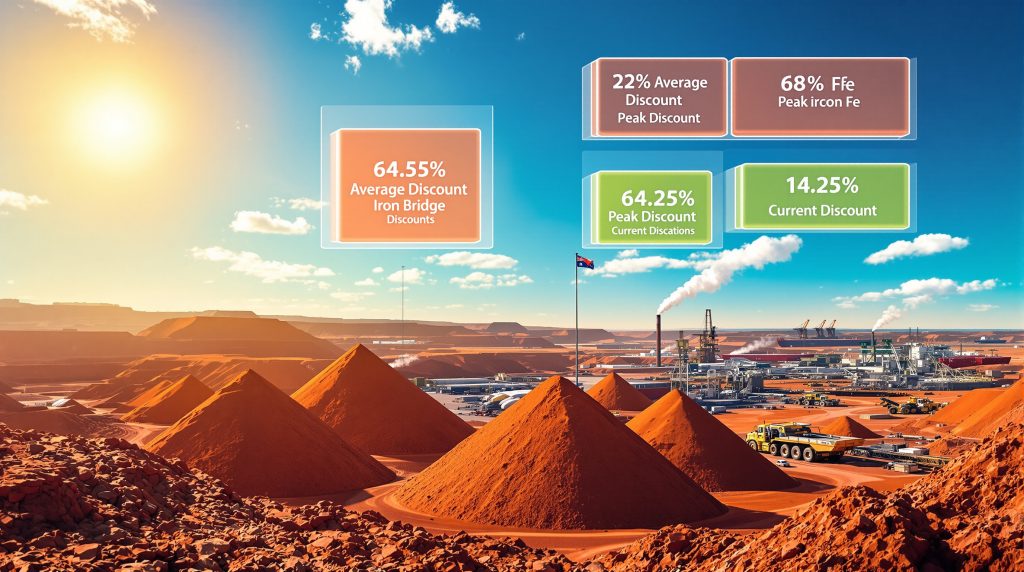Understanding Fortescue's Iron Ore Quality Challenges
Fortescue's iron ore consistently trades at significant discounts to benchmark pricing due to fundamental quality differences that create operational challenges for steel manufacturers. The company's primary product contains approximately 57-58% iron content, substantially below the industry standard 62% benchmark used for global pricing references. Furthermore, these iron ore price trends reflect broader market dynamics affecting quality-sensitive producers.
The Science Behind Quality-Based Price Penalties
Iron ore quality directly impacts steel production efficiency through several technical mechanisms. Lower-grade ores require steel producers to process larger volumes of material to achieve equivalent iron output, creating cascading cost increases throughout the manufacturing chain.
Technical Impact Factors:
• Higher slag volumes during smelting operations
• Increased coke consumption per tonne of steel produced
• Reduced blast furnace throughput rates
• Additional beneficiation requirements before processing
• Enhanced sintering complexity for feed preparation
These technical disadvantages force steel manufacturers to adjust their procurement strategies, typically demanding price concessions that reflect the additional processing costs and reduced operational efficiency.
Quantifying Fortescue's Discount Exposure
The Fortescue iron ore discount varies significantly based on market dynamics, steel industry margins, and global supply-demand balance. Historical analysis reveals substantial variation in discount levels across different market cycles. In addition, recent price decline insights provide valuable context for understanding these fluctuations.
Historical Discount Performance Analysis
| Time Period | Discount Rate | Market Conditions | Price Impact |
|---|---|---|---|
| 10-year average | 22% below benchmark | Mixed market cycles | Structural disadvantage |
| Q1 2022 | 32% below benchmark | Oversupply conditions | Maximum penalty |
| Recent quarters | 13-17% range | Moderate weakness | Current baseline |
| Q1 2026 | 13% discount | Improved steel margins | Narrowed differential |
Recent operational data shows encouraging trends, with Q1 2026 shipments reaching 49 million metric tons, representing a 4% year-over-year increase despite being 10% lower than the previous quarter. Fortescue's strong Q1 performance demonstrates resilience amid challenging market conditions. Unit cash costs improved to approximately USD $18.20 per metric ton, reflecting 10% lower costs compared to the previous year.
Market Psychology Behind Discount Fluctuations
Steel industry margin health directly influences how severely quality penalties impact pricing. During periods of strong steel profitability, manufacturers become less sensitive to iron ore grade differences, allowing lower-quality producers to narrow their discounts. However, these miners' demand insights reveal complex market dynamics affecting pricing strategies.
Discount Amplification Factors:
• Chinese property sector construction demand
• Manufacturing steel consumption patterns
• Inventory management practices by steel mills
• Transportation cost variations affecting delivered pricing
• Competitor capacity utilization rates
Strategic Response: Iron Bridge Premium Product Development
Fortescue's Iron Bridge joint venture represents a fundamental shift in product quality strategy, targeting premium market segments through higher-grade ore production. This 69% Fortescue-owned, 31% Formosa Steel partnership produces 67% iron content ore that commands an 18% premium to the 62% benchmark.
Technical Specifications and Market Impact
Iron Bridge's 22 million tonnes annual capacity at full operation provides crucial blending opportunities for Fortescue's overall product portfolio. When combined with traditional hematite production, the blended average grade rises to 58-59% iron content, improving competitive positioning against major producers. Consequently, these improvements help establish global mining benchmarks for quality standards.
Competitive Benchmarking:
• Vale: 63-64% average iron content
• BHP and Rio Tinto: 61-62% average iron content
• Fortescue (post-Iron Bridge): 58-59% average iron content
• Fortescue (traditional hematite): 57-58% average iron content
The strategic importance of Iron Bridge extends beyond immediate pricing benefits. Industry analysts anticipate Fortescue's total production capacity reaching 210 million metric tons by fiscal 2030, with Iron Bridge contributing approximately 15 million metric tons of Fortescue's share once fully operational by fiscal 2028.
Geological Constraints and Long-Term Challenges
Fortescue's iron ore deposits in the Pilbara region present inherent geological limitations that constrain quality improvement potential. Unlike competitors with access to naturally higher-grade reserves, Fortescue must rely on operational efficiency and strategic blending to optimise product quality.
Reserve Quality Analysis
The company's rapid expansion from 55 million metric tons capacity in fiscal 2012 to approximately 195 million metric tons by 2025 represents unprecedented growth in the iron ore sector. However, this expansion occurred during peak commodity pricing, resulting in higher capital costs per unit of output compared to established producers who developed capacity during lower-cost periods.
Structural Disadvantages:
• Lower-grade reserve base compared to diversified miners
• Higher capital intensity per tonne of production capacity
• Geographic concentration in single mining region
• Limited beneficiation infrastructure relative to global competitors
• Constrained blending options without premium-grade acquisitions
Market Dynamics Affecting Discount Volatility
Chinese steel industry dynamics fundamentally drive Fortescue's pricing realisation, given that virtually all production is sold to Chinese steel manufacturers. The relationship between steel industry profitability and iron ore quality sensitivity creates cyclical patterns in discount application.
What Factors Drive Steel Industry Margin Impact on Quality Premiums?
During periods of robust steel industry margins, manufacturers prioritise supply security over marginal quality differences. This environment allows lower-grade producers to achieve narrower discounts as buyers focus on volume assurance rather than optimisation of input costs.
Current Market Indicators:
• Chinese steel capacity reduction initiatives supporting margin improvement
• Infrastructure replacement demand providing baseline consumption
• Environmental regulations favouring efficient production methods
• Supply chain optimisation trends emphasising total cost analysis
Conversely, margin compression periods intensify focus on operational efficiency, amplifying quality-based pricing penalties as steel producers seek to optimise input costs through selective procurement strategies.
Investment Implications of Quality-Based Pricing
Understanding Fortescue's iron ore discount provides crucial context for evaluating investment prospects and risk assessment. The company's position as a pure-play iron ore producer creates concentrated exposure to both commodity pricing cycles and quality-based market dynamics. Furthermore, overvalued ASX mining companies face additional scrutiny from market analysts.
Valuation Framework Considerations
Fortescue currently trades at 23% above Morningstar's $16.60 fair value estimate, reflecting market optimism regarding Chinese steel price recovery. The company maintains a no-moat rating due to structural competitive disadvantages relative to diversified mining companies.
Investment Risk Factors:
• Cyclical sensitivity: Quality discounts amplify both positive and negative price movements
• Margin compression risk: Lower-grade products face disproportionate pressure during downturns
• Competitive positioning: Structural disadvantages versus diversified miners with higher-grade reserves
• Strategic execution risk: Green energy transition timeline and profitability uncertainty
• Geographic concentration: Heavy reliance on Chinese demand patterns
Performance Monitoring Framework
Investors should track specific metrics that illuminate Fortescue's competitive position evolution and strategic progress toward quality improvement.
Critical Performance Indicators:
| Metric | Significance | Target Range |
|---|---|---|
| Realised pricing vs benchmark | Primary profitability driver | Monitor quarterly |
| Iron Bridge production ramp | Strategic execution measure | 15Mt capacity target |
| Average product grade evolution | Quality improvement tracking | 58-59% target blend |
| Unit cash cost trends | Operational efficiency | Sub-$18.50 USD target |
| Chinese steel industry margins | Demand environment health | Industry reports |
Future Market Evolution and Strategic Positioning
Long-term industry trends present both challenges and opportunities for quality-sensitive iron ore producers. The transition toward more environmentally conscious steel production methods may alter traditional quality-price relationships. Moreover, these decarbonisation benefits create new market dynamics for resource companies.
Emerging Technology Impact on Quality Preferences
Direct reduction steelmaking processes, gaining adoption for environmental reasons, typically favour higher-grade iron ore inputs. This technological shift could potentially increase quality premiums over time, intensifying competitive pressure on lower-grade producers.
Structural Market Changes:
• Green steel production methods favouring premium inputs
• Carbon pricing mechanisms affecting energy-intensive processing
• Supply chain consolidation improving pricing discipline
• Infrastructure renewal creating replacement demand cycles
• Emerging market steel consumption growth patterns
However, Fortescue's strategic transformation into a diversified iron ore and clean energy company addresses long-term competitive challenges through business model evolution beyond traditional mining operations.
Risk Management Through Strategic Diversification
Fortescue's green energy initiatives represent recognition that traditional iron ore quality constraints require strategic solutions beyond operational optimisation. While these initiatives remain at early development stages, they demonstrate management's awareness of structural competitive challenges.
Strategic Transformation Elements
The company's pivot toward clean energy technologies acknowledges that sustained competitive advantage requires moving beyond commodity production into higher-value applications. This strategic direction aims to reduce dependence on iron ore quality differentials through business model diversification.
Transformation Components:
• Green hydrogen production capabilities
• Renewable energy infrastructure development
• Technology partnerships for emission reduction
• Direct reduction steelmaking process integration
• Carbon-neutral mining operations advancement
"The iron ore industry faces fundamental changes as environmental considerations increasingly influence steel production methods and input preferences, creating both challenges and opportunities for traditional producers."
Conclusion: Navigating Quality-Based Market Dynamics
Fortescue's iron ore discount reflects genuine competitive disadvantages that require strategic solutions beyond operational improvements. While the company has demonstrated remarkable success in cost reduction and volume expansion, structural quality differences ensure continued pricing pressure relative to benchmark rates.
The Iron Bridge joint venture provides a pathway for gradual quality improvement, but fundamental reserve characteristics limit the extent of potential enhancement. Investors must evaluate whether management's strategic diversification initiatives can successfully offset traditional competitive disadvantages.
Investment Decision Framework:
• Balance cost leadership position against quality-based limitations
• Assess strategic transformation execution probability and timeline
• Monitor Chinese steel industry health as primary demand indicator
• Evaluate green energy initiative commercial viability
• Consider portfolio concentration risk from pure-play iron ore exposure
Success will ultimately depend on management's ability to execute strategic transformation while maintaining operational excellence in core iron ore production. The company's future prospects rest on successfully navigating the transition from traditional commodity producer to diversified resources and clean energy enterprise.
Ready to Capitalise on ASX Mining Opportunities?
Discovery Alert's proprietary Discovery IQ model delivers real-time alerts on significant mineral discoveries across the ASX, helping investors identify actionable opportunities in iron ore and other commodity sectors before market movements occur. Begin your 30-day free trial today and discover why major mineral discoveries can generate substantial returns by exploring our dedicated discoveries page.




